View All Plants :: View All DECIDUOUS SHRUBS :: View All TREES
Magnolia x soulangiana 'Milliken'
Saucer Magnolia
Plant Type:
DECIDUOUS SHRUBSMagnolia x soulangiana ‘Milliken’ – 'Milliken' is another witch’s broom found on a Saucer Magnolia in New York. It is larger growing than ‘Kiki’s Broom’ sporting large white, feathered pink-purple vase-shaped flowers with typical fragrance, blooming mid-spring in eastern Connecticut, earlier in the south. As with 'Kiki's Broom' in winter the totality of the shrub casts a light yellow-olive color – not “killer” winter interest but in context with other contrasting winter-interest plants it's an enriching element. Northern gardeners: please purchase and plant only in spring.
Characteristics and Attributes for Magnolia x soulangiana 'Milliken'
Season of Interest (Flowering)
- Spring
Season of Interest (Foliage)
- Spring / Summer / Autumn
Interesting Bark
- Smooth
Autumn Interest
- Autumn Leaf Color
- Showy Buds
Nature Attraction
- Deer Resistant
Light
- Full Sun
- Mostly Sunny
Attributes
- Hedgerow
- Border
- Heath / Peat Garden
- Fragrant
- Foundation
- Specimen
- Shrub Border
- Hedge
Growth Rate in the Garden
- Medium
Soil
- Fertile
- Organic
- Moist
Origins
- Garden Origin
Propagated By
- Cutting Grown
Genus Overview: Magnolia
Common Name: Magnolia
The Magnolias are one of the earliest known flowering plants to establish themselves on our beautiful planet. Much breeding continues and the cultivar list is expanding with some smaller sizes and new flower colors. Many are typical tree forms while some tend to be multi-stemmed – more like huge shrubs than single-stemmed trees. Most are spring blooming – some early, others later after danger of frost has passed in the north. A few of these will provide some recurrence of bloom during the summer. A handful bloom in summer. Many emit wonderful fragrance. The foliage is often large, bold and paddle-shaped, looking attractive in summer; a handful of species’ leaves are so large that they are reminiscent of banana foliage. Some seasons they develop gold to golden brown autumn color before the leaves drop. It’s hard for me to think of a landscape without one or more included in the mix. All prefer fertile deep loam with plenty of organic matter and moist soils – some are even content in relatively wet conditions. Magnolias should be sited in full to half sun exposures. All our selections are cutting grown, on their own wood – they are not grafted. Some are much easier to produce on their own wood than others; some are quite recalcitrant. In that, we may not always have certain plants available or available in great numbers. Spring planting is recommended for magnolias especially up north. Cutting grown.


